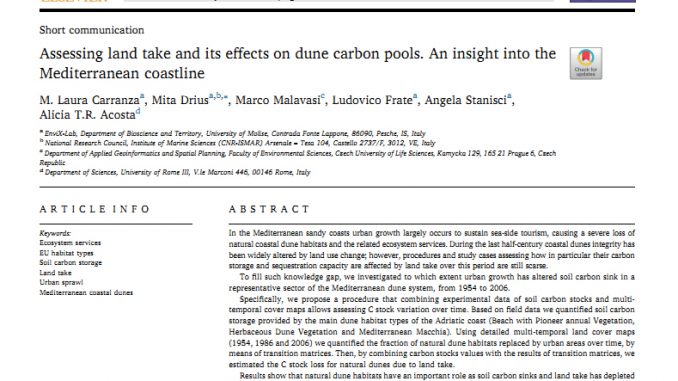
n the Mediterranean sandy coasts urban growth largely occurs to sustain sea-side tourism, causing a severe loss of natural coastal dune habitats and the related ecosystem services. During the last half-century coastal dunes integrity has been widely altered by land use change; however, procedures and study cases assessing how in particular their carbon storage and sequestration capacity are affected by land take over this period are still scarse.
To fill such knowledge gap, we investigated to which extent urban growth has altered soil carbon sink in a representative sector of the Mediterranean dune system, from 1954 to 2006.
Specifically, we propose a procedure that combining experimental data of soil carbon stocks and multi-temporal cover maps allows assessing C stock variation over time. Based on field data we quantified soil carbon storage provided by the main dune habitat types of the Adriatic coast (Beach with Pioneer annual Vegetation, Herbaceous Dune Vegetation and Mediterranean Macchia). Using detailed multi-temporal land cover maps (1954, 1986 and 2006) we quantified the fraction of natural dune habitats replaced by urban areas over time, by means of transition matrices. Then, by combining carbon stocks values with the results of transition matrices, we estimated the C stock loss for natural dunes due to land take.
Results show that natural dune habitats have an important role as soil carbon sinks and land take has depleted them with different rates, causing a total net loss of 117 t of soil C in the first time step and a total net loss of 70 t of soil C in the second time step (∼40% of soil C stock in the last 53 years).
Our work underlines the fragility of natural coastal dunes, which during the last decades have become a privileged destination for touristic and recreational activities, thus been progressively replaced by artificial areas, with a direct impact on their carbon storage capacity and the other precious services they provide.
By combining ecosystem services measurements with multi-temporal mapping techniques, we enhanced our understanding of transformation processes on coastal dunes, offering as well new insights for dune management.
https://www.sciencedirect.com/science/article/pii/S1470160X17306908

Commenta per primo